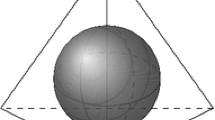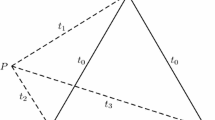Abstract
A d-dimensional simplex is a collection of d+1 sets with empty intersection, every d of which have nonempty intersection. A k-uniform d-cluster is a collection of d+1 sets of size k with empty intersection and union of size at most 2k.
We prove the following result which simultaneously addresses an old conjecture of Chvátal [6] and a recent conjecture of the second author [28]. For d≥2 and ζ >0 there is a number T such that the following holds for sufficiently large n. Let G be a k-uniform set system on [n] ={1,…,n} with ζ n<k <n/2−T, and suppose either that G contains no d-dimensional simplex or that G contains no d-cluster. Then |G|≤\( \left( {\begin{array}{*{20}c} {n - 1} \\ {k - 1} \\ \end{array} } \right) \) with equality only for the family of all k-sets containing a specific element.
In the non-uniform setting we obtain the following exact result that generalises a question of Erdős and a result of Milner, who proved the case d=2. Suppose d≥2 and G is a set system on [n] that does not contain a d-dimensional simplex, with n sufficiently large. Then |G|≤2n−1+Σ d−1i=0 \( \left( {\begin{array}{*{20}c} {n - 1} \\ i \\ \end{array} } \right) \), with equality only for the family consisting of all sets that either contain some specific element or have size at most d−1.
Each of these results is proved via the corresponding stability result, which gives structural information on any G whose size is close to maximum. These in turn rely on a stability theorem that we obtain using an earlier result of Frankl.
Similar content being viewed by others
References
R. Ahlswede and L. H. Khachatrian: The complete intersection theorem for systems of finite sets, European J. Combin.18 (1997), 125–136.
R. P. Anstee and P. Keevash: Pairwise intersections and forbidden configurations, European J. Combin.27 (2006), 1235–1248.
T. M. Apostol: An elementary view of Euler’s summation formula, Amer. Math. Monthly106 (1999), 409–418.
J. Balogh, B. Bollobás and M. Simonovits: The number of graphs without forbidden subgraphs, J. Combin. Theory Ser. B91 (2004), 1–24.
J. C. Bermond and P. Frankl: On a conjecture of Chvátal on m-intersecting hypergraphs, Bull. London Math. Soc.9 (1977), 310–312.
V. Chvátal: An extremal set-intersection theorem, J. London Math. Soc.9 (1974/75), 355–359.
R. Csákány and J. Kahn: A homological approach to two problems on finite sets, J. Algebraic Combin.9 (1999), 141–149.
I. Dinur and E. Friedgut: Intersecting families are essentially contained in juntas, Combin. Probab. Comput.18(1–2) (2009), 107–122.
I. Dinur and S. Safra: On the hardness of approximating minimum vertex cover, Ann. of Math. (2)162 (2005), 439–485.
P. Erdős: Topics in combinatorial analysis, in: Proc. Second Louisiana Conf. on Comb., Graph Theory and Computing (R. C. Mullin et al., eds.), pp. 2–20, Louisiana State Univ., Baton Rouge, 1971.
P. Erdős, H. Ko and R. Rado: Intersection theorems for systems of finite sets, Quart. J. Math. Oxford Ser.12 (1961), 313–320.
P. Frankl: On Sperner families satisfying an additional condition, J. Combin. Theory Ser. A20 (1976), 1–11.
P. Frankl: On a problem of Chvátal and Erdős on hypergraphs containing no generalized simplex, J. Combin. Theory Ser. A30 (1981), 169–182.
P. Frankl: Erdős-Ko-Rado theorem with conditions on the maximal degree, J. Combin. Theory Ser. A46 (1987), 252–263.
P. Frankl and Z. Füredi: A new generalization of the Erdős-Ko-Rado theorem, Combinatorica3(3–4) (1983), 341–349.
P. Frankl and Z. Füredi: Exact solution of some Turán-type problems, J. Combin. Theory Ser. A45 (1987), 226–262.
E. Friedgut: On the measure of intersecting families, uniqueness and stability; Combinatorica28(5) (2008), 503–528.
Z. Füredi, O. Pikhurko and M. Simonovits: On Triple Systems with Independent Neighborhoods, Combin. Probab. Comput.14 (2005), 795–813.
Z. Füredi, O. Pikhurko and M. Simonovits: 4-Books of three pages, J. Combin. Theory Ser. A113 (2006), 882–891.
Z. Füredi and M. Simonovits: Triple systems not containing a Fano configuration, Combin. Probab. Comput.14 (2005), 467–484.
A. J. W. Hilton and E. C. Milner: Some intersection theorems for systems of finite sets, Quart. J. Math. Oxford Ser.18 (1967), 369–384.
S. Janson, T. Łuczak and A. Ruciński: Random Graphs, Wiley, (2000).
P. Keevash and D. Mubayi: Stability results for cancellative hypergraphs, J. Comb. Theory Ser. B92 (2004), 163–175.
P. Keevash and B. Sudakov: The Turán number of the Fano plane, Combinatorica25(5) (2005), 561–574.
P. Keevash and B. Sudakov: On a hypergraph Turán problem of Frankl, Combinatorica25(6) (2005), 673–706.
D. Mubayi: Structure and Stability of Triangle-free set systems, Trans. Amer. Math. Soc.359 (2007), 275–291.
D. Mubayi: An intersection theorem for four sets, Advances in Mathematics215(2) (2007), 601–615.
D. Mubayi: Erdős-Ko-Rado for three sets, J. Combin. Theory Ser. A113 (2006), 547–550.
D. Mubayi and O. Pikhurko: A new generalization of Mantel’s theorem to k-graphs, J. Combin. Theory Ser. B97(4) (2007), 669–678.
D. Mubayi and J. Verstraëte: Proof of a conjecture of Erdős on triangles in setsystems, Combinatorica25(5) (2005), 599–614.
D. Mubayi and J. Verstraëte: Minimal paths and cycles in set systems, European J. Combin.28(6) (2007), 1681–1693.
O. Pikhurko: Exact computation of the hypergraph Turán function for expanded complete 2-graphs, accepted, J. Combin. Theory Ser. B (publication suspended for an indefinite time, see http://www.math.cmu.edu/~pikhurko/Copyright.html).
O. Pikhurko: An exact Turán result for the generalized triangle, Combinatorica28(2) (2008), 187–208.
H. Robbins: A remark on Stirling’s formula, Amer. Math. Monthly62 (1955), 26–29.
M. Simonovits: A method for solving extremal problems in graph theory, stability problems; in: 1968 Theory of Graphs (Proc. Colloq., Tihany, 1966), pp. 279–319, Academic Press, New York.
Author information
Authors and Affiliations
Corresponding author
Additional information
Research supported in part by NSF grant DMS-0555755.
Research partially supported by National Science Foundation Grant DMS-0400812, and an Alfred P. Sloan Research Fellowship.




